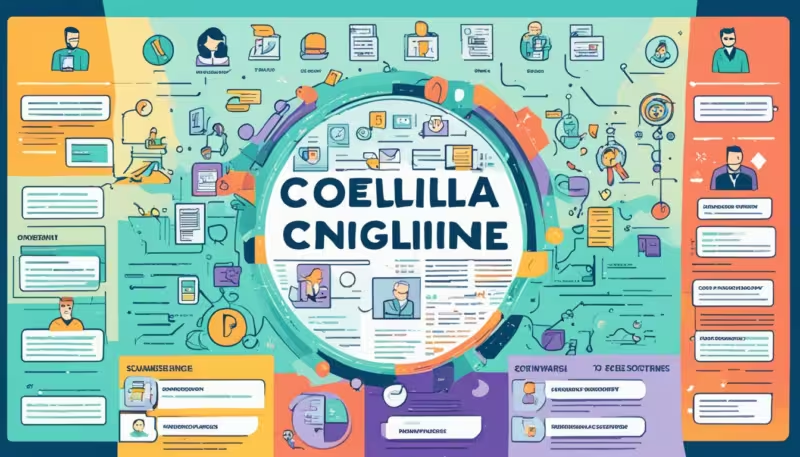What if the key to your dream software engineering job is how you show yourself online?
Today’s job market is tough. Recruiters look at countless resumes, spending only 5-7 seconds on each. As a software engineer, it’s vital your resume quickly shows your skills and achievements. This is even more important if the reader isn’t tech-savvy. Using smart resume and LinkedIn tips can make you stand out.
LinkedIn lets you share more than a resume, with no limit on page length. You can give details on your work and what you’ve overcome. This gives a full picture to recruiters. Remember, about 90% of them check LinkedIn before calling for an interview. So, a good profile is essential.
This guide will discuss making a resume and LinkedIn profile that stand out. We will talk about using AI tools to enhance your qualifications. These steps aim to help you make a strong impression in the field.
The Importance of a Well-Crafted Resume
Creating a strong first impression is key in today’s job market. Your resume is often the first thing employers see. A well-made professional software developer resume can help you land your dream job. It shows your skills and sets you apart from others.
Why First Impressions Matter
Hiring managers typically look at a resume for about six seconds. This short time highlights the importance of making a good first impression. A good resume is short, about one or two pages, making your skills and achievements clear at first glance. Employers look for candidates who are good communicators, which is vital for teamwork.
To make your resume stand out, tailor it to the job you’re applying for. If you’re emailing your resume, get specific instructions from the company if possible.
Common Mistakes to Avoid
There are several mistakes that can hurt your chances of getting an interview:
- Inconsistent formatting: Uniformity in fonts, bullet points, and spacing shows professionalism and care.
- Unverified skill listings: Being honest about your abilities builds trust. Don’t exaggerate your skills.
- Inadequate proofreading: Spelling and grammar mistakes can make you look unprofessional. Always proofread your resume.
- Lack of quantifiable accomplishments: Use specific metrics to highlight your achievements. This shows the real impact of your work.
- Over-personalization: Include hobbies only if they improve your professional image and relate to the job.
- Overly lengthy documents: Keep your resume short and relevant. Long resumes can lose the reader’s interest.
Avoiding these common errors can help you present yourself effectively. A well-crafted resume opens doors to career opportunities and growth in software development.
Creating a Strong Professional Summary
Making a strong professional summary is key to getting noticed fast by recruiters. It’s important to use specific details that show off your skills, experience, and successes. This helps paint a picture of what you bring to the table.
What to Include in Your Summary
Your resume summary for software engineers should have a few key parts:
- Concise Statements: Keep it to three to five sentences that make your main skills and experiences clear.
- Quantifiable Achievements: Use real numbers, like percentages or team sizes, to show your accomplishments. Like, “Led a team of 20 engineers, boosting project efficiency by 30%.”
- Relevant Keywords: Pick words related to the job you’re applying for. This helps your resume get through tracking systems.
- Clear Career Objectives: Share your career goals to show your ambition and direction.
Examples of Effective Summaries
Here are good examples of resumes for software engineers:
- “Experienced Software Engineer, expert in building efficient systems, cut costs by 15%, led teams to successful launches.”
- “Creative Software Developer with over 5 years in full-stack. Improved API efficiency by 40%, always beating performance goals.”
- “Skilled DevOps Engineer, great with automation, cloud management, and enhancing CI/CD pipelines, made release cycles 25% faster.”
Make sure your summary fits each job you apply for. Change it to match the role and company. A well-made summary makes your resume strong. It helps you stand out in a crowded job market.
Highlighting Technical Skills Effectively
In the world of software engineering, showing your technical skills well on your resume is key. To stand out to employers, knowing how to list and display your tech skills is vital. This includes your knowledge in programming languages and other technical areas.
Essential Skills for Software Engineers
Software engineers need a broad range of tech skills. You should mention your knowledge in popular programming languages. This includes Python, JavaScript, C++, C#, SQL, and HTML. Knowing tools like Git and Docker is also valuable. These skills show your tech knowledge and your ability to handle various projects.
Other important tech skills are:
- Data Structures and Algorithms
- Version Control/Git
- Continuous Integration/Continuous Deployment (CI/CD)
- Database Management
- Cloud Computing (AWS, Azure, GCP)
How to Showcase Proficiency
You can show your skill in programming and other areas in different ways. A strong approach is giving examples of projects where you used these skills. Mentioning a project that used Python for data analysis or JavaScript for web development is helpful.
Bullet points that highlight what you achieved are also good on your resume. For example:
- Developed a full-stack web application using React and Node.js, which increased user engagement by 30%.
- Led a team in migrating a system to AWS, cutting server costs by 20%.
- Built a CI/CD pipeline using Jenkins, which sped up release cycles by 40%.
Adding tables or charts to show your skills can really make your resume stand out. They let you visually align your skills with job needs. This makes it easy for hiring managers to see what you can do.
Being clear about your technical skills and showing real achievements can up your chances for a software engineering job.
Showcasing Work Experience
The work experience section on a software engineer’s resume is crucial. It’s where you highlight your skills and qualifications. You detail your professional experience to show your value to potential employers. It’s essential to organize this section well. You should show how your past roles have helped your career in software engineering.
Structuring Your Experience
Employers like a clear and organized resume work history. They prefer it in reverse chronological order. This showcases your career progression. Each job entry should clearly describe your roles. Make sure to include:
- The job title
- The company name
- How long you worked there
- Main responsibilities
- Key achievements
Include metrics and outcomes in your descriptions. For instance, say “increased system efficiency by 25%” or “led a team to create a new software solution, saving $50,000 a year”. These specifics highlight your skills and the impact you’ve made.
Emphasizing Accomplishments Over Duties
It’s better to focus on what you’ve achieved rather than what you were supposed to do. Potential employers are more interested in your results. For example:
- Implemented a new system that raised user retention by 20%.
- Spearheaded a team to develop a top-performing mobile app.
- Directed a project that cut processing times by 15%.
By using action words like “launched,” “coordinated,” and “increased,” your resume packs a stronger punch. Make sure your achievements are measurable. This gives a clear view of what you can do. Whether it’s a full-time job or freelance work, showcasing your software engineering successes is key to a standout resume.
Featuring Key Projects and Contributions
Making your software engineering projects stand out is key to moving forward in your career. Showcasing your major projects and personal efforts shows off your skills and passion. Be specific about the challenges you tackled and the successes you achieved to standout.
If you’re just starting out, share your coding or school projects. This shows how you use what you’ve learned in real-life situations. For those changing careers, pick projects that show skills you can use in the new job.
Your portfolio can include what you’ve done alone, with a team, or as a volunteer. A great project description should have:
- An interesting project title
- A clear description and dates
- Detailed roles and responsibilities
- Clear results and impact
Let’s say you were part of a software project that boosted efficiency by 20%. It also increased customer loyalty by 15% and cut support questions by 30%. These solid numbers prove your skills and make your portfolio stand out in job hunts.
The goal of showcasing your projects is to show what you’re capable of. Whether it’s school, personal, team, or leadership projects, make sure they match the job you want. This makes your application more relevant and powerful.
Resume Building Tips for Software Engineers
Making your resume stand out is key in a tough job market. Let’s look at how to improve your resume’s layout for a great first impression.
Optimizing Format and Length
Most people apply for jobs online, but this approach often fails due to stiff competition. It’s best to keep your resume short but informative. In the US, a one-page resume works well for those early in their careers. Meanwhile, in Europe, two pages may be better, especially for senior positions.
Since recruiters glance at resumes for just 6 seconds, being clear is crucial. Use a simple font and consistent format for a professional look. Stick to relevant information to keep your resume sharp and effective.
Using Bullet Points and Clear Language
Use bullet points to make your resume easier to read quickly. Be specific about your achievements and tasks. Stay away from technical terms that might confuse non-tech recruiters.
Add sections like a professional summary and key projects to catch an employer’s eye. Don’t forget to include important courses and certifications in your Education section.
Your aim is to create a resume that’s polished and convincing enough to get interviews at big tech firms. A good resume clearly communicates your achievements without overwhelming the reader.
Detailing Certifications and Education
In the tech world, your software engineer certifications and studies must be on your resume. These show your skill and love for learning, vital in a changing field. As recruiters glance at resumes for just 5 seconds, clear and brief presentation is key.
Relevant Certifications for Software Engineers
Holding certifications gives you an edge in a tough job market. If there’s an average of 180 applications for each job, consider adding:
- Microsoft Certified: Azure Developer Associate
- Google Professional Cloud Architect
- Certified Kubernetes Administrator (CKA)
- PMP: Project Management Professional
These certifications show you’re great with the latest tech and can manage projects well. Employers look for these skills, so choose certifications that fit the job.
How to Present Your Educational Background
Your educational background on your resume is also crucial. Recruiters want to see strong educational records, especially in tech. List your top qualifications first:
- Bachelor of Science in Computer Science, MIT, 2015-2019
- Master of Science in Software Engineering, Stanford University, 2019-2021
- Relevant Education: Certificate in Business, 2016-2017
Customizing your resume is important. Match your education to the job you want. Showing job-specific skills makes your resume more noticeable.
Try to keep technical terms to a minimum. Instead, make your tech industry qualifications clear for a strong first impression. Make sure there are no typos or grammar mistakes to stay professional.
Customizing Your Resume for Each Application
Adapting your resume for each job makes your profile stand out. It doesn’t matter if you’re aiming for a big company, a small startup, or a consulting job. Tailoring your resume shows you’re really interested and fit the job needs.
Adapting Content for Different Job Roles
Making specific changes to your resume is key. Here are six tips:
- Include how many years you’ve worked in Marketing Management right in your summary.
- Talk about your successes with numbers to show what you’ve accomplished.
- Use important words from the job description to get noticed.
- Don’t forget to list your main skills and strengths in a skills section.
- Put your most important skills at the top of your resume.
- Choose job experiences that match what you’re applying for now. If you’re changing your career path, skip the unrelated jobs.
Highlighting Job-Specific Skills
It’s really important to show off your skills. Here’s how:
- Link your achievements to what the job asks for using key words.
- More than 90% of recruiters say you should tailor your resume for each job.
- If you’re thinking of changing careers, a functional resume can highlight your skills better.
- Remember, ATS software checks for specific words. Use Jobscan to make your resume better.
- Making your resume fit the job can really help you get interviews, especially in places like the USA and Canada where it’s very competitive.
Tailoring your resume helps you match the job better. It also shows you’re professional and careful, which boosts your chances in getting a job.
LinkedIn Profile Best Practices
Your LinkedIn profile is more than just an online CV. It’s your professional story with your own personal twist. Making your LinkedIn stand out to recruiters can lead you to new job opportunities.
Start with a professional photo of yourself and a catchy background image. Your headline should neatly state what you do, like “Software Engineer Specializing in Cloud Computing and AI.” This is a key step for making your profile easy to find.
Keeping your profile updated is key. LinkedIn suggests tweaking up to 20 parts of your profile. This includes your photo, bio, skills, and headline. A lively summary of your career can make your profile really pop. It should showcase what you love, what you’ve done, and what makes you unique.
Endorsements and recommendations help show you’re great at what you do. Try to get endorsements for your main skills from people you know. Also, ask for recommendations to back up your skills. For software engineers, this could mean getting props for your technical skills or positive feedback on projects.
Earning badges from places like LinkedIn Learning shows you’re all about growing your skills. This highlights that you’re up-to-date in your field. Sharing stuff like case studies and articles also puts your expertise front and center.
Becoming active on LinkedIn can really up your game. Post interesting articles and thoughts, and interact with others’ posts to get noticed. Follow leaders in your field to fill your feed with insightful content. Share this content to show you’re engaged in your industry.
Writing an Engaging LinkedIn Summary
Creating a standout LinkedIn summary is key in today’s busy world. Here, you’ll find advice on making your LinkedIn story engaging, improving your profile’s searchability, and catching your audience’s attention.
How to Tell Your Professional Story
Your LinkedIn summary is your chance to share your story beyond your resume. Start with an engaging opening to draw in the reader. Then, briefly cover your career path and main achievements. Use real-life examples, like Tanmoy from Peloton who values diversity, or Magdalena from Cisco who brings a global viewpoint. These stories connect on a personal level. Don’t forget to share your motivations, the obstacles you’ve overcome, and your successes. This shows your commitment and love for your field.
Keywords and Searchability
Using the right keywords is crucial for being found on LinkedIn. Pick words that match your skills, like ‘content,’ ‘management,’ and ‘analysis.’ This boosts how visible your profile is. Take Katrina, a senior software developer, as an example. Her profile stands out because it’s filled with relevant skills. Focus on roles, specialties, and your wins to draw the right kind of attention. The start of your summary is especially important. Make those first three lines engaging to encourage people to read more.
Your LinkedIn summary should do more than list successes and skills. It needs to tell a story that grabs attention. Make sure to invite your readers to do something after reading. Personalize your summary to make it yours. A great LinkedIn profile balances a personal touch with strategic keywords. This makes you more appealing to both hiring managers and colleagues, helping you succeed in your career.
Optimizing Your LinkedIn Headline
Over 90% of recruiters use LinkedIn to find talent. So, a strong LinkedIn headline is crucial. It should quickly share your role and goals. This way, it shows what you do now and what you aim to achieve in the future.
Your LinkedIn headline is key to your professional brand. You can use up to 220 characters to include important keywords. These keywords make you more visible to recruiters. Avoid common buzzwords. Instead, offer a clear value proposition to stand out.
Your headline lets you showcase your unique skills and experiences. Using the right keywords and a value statement makes you noticeable. A well-crafted headline helps your profile pop up in searches, opening up more opportunities.
Here are some tips for making your LinkedIn headline catch eyes:
- Be clear and concise: Mention your current job and a few special skills or achievements.
- Incorporate keywords: Choose words recruiters might use when looking for someone with your skills.
- Add a value proposition: Show how you can bring value to a future employer or project.
Keeping everything consistent on your LinkedIn profile is important. Your headline should match the rest of your profile to create a professional image. A good headline does more than list your job. It shares a glimpse of who you are professionally and what you aspire to do, helping you attract the right kind of attention.
Conclusion
Creating a top-notch software engineer resume and LinkedIn profile is more than just listing your skills. It’s a key strategy for moving ahead in your career. In 2024, using a resume builder is super helpful. These builders help you make professional, ATS-friendly resumes quickly. By using AI, they tailor your resume for job applications, improving your chances to get interviews.
This article shared top tips for making your resume stand out. It’s crucial to customize your resume for each job. You should highlight your technical skills, use modern templates, and organize your information well. Using action verbs makes your achievements shine. Also, keep your resume and LinkedIn up to date to reflect your career growth.
Resume builders offer more than just resume help. They also provide cover letter tools and interview advice, helping you through the job application process. For software engineers looking to succeed, these tools are essential. As the job market changes, showing care and attention in your resume and LinkedIn profile is vital. They open doors to exciting job opportunities.






